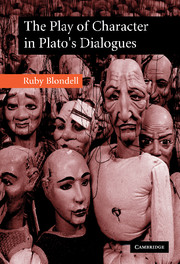Book contents
- Frontmatter
- Contents
- Preface
- 1 Drama and dialogue
- 2 The imitation of character
- 3 The elenctic Sokrates at work: Hippias Minor
- 4 A changing cast of characters: Republic
- 5 Reproducing Sokrates: Theaetetus
- 6 Putting Sokrates in his place: Sophist and Statesman
- Bibliography
- General index
- Index of passages cited
5 - Reproducing Sokrates: Theaetetus
Published online by Cambridge University Press: 22 September 2009
- Frontmatter
- Contents
- Preface
- 1 Drama and dialogue
- 2 The imitation of character
- 3 The elenctic Sokrates at work: Hippias Minor
- 4 A changing cast of characters: Republic
- 5 Reproducing Sokrates: Theaetetus
- 6 Putting Sokrates in his place: Sophist and Statesman
- Bibliography
- General index
- Index of passages cited
Summary
Theaetetus stands out among Plato's dialogues for its blurring of the boundaries between various proposed groupings of his works. It is self-consciously “Socratic” in the elenctic manner, uses the rich scene-setting and characterization, substantial argumentation, and eloquent Socratic speech-making associated with the constructive Sokrates, and overlaps with the “late” dialogues in important aspects of both style and content. In a more methodologically innocent age, its aporetic structure was taken by some as evidence of an early date; more recently, Theaetetus has been seen as anomalous among the later dialogues, prompted perhaps by a desire to pay homage to the eponymous interlocutor after his death. But whatever other reasons there may be for its unusual combination of elements, it displays a richness of characterization that serves to mark Plato's continuing preoccupation with the relations between personality, literary form, philosophical method and Socratic pedagogy. Through Sokrates, Theaitetos, Theodoros, and their interactions, Plato explores yet again the conditions under which Socratic pedagogy may successfully take place. Republic Book 1 asked, in dramatic terms, who could hope to learn from the elenctic Sokrates, while Books 2–10 showed what kind of interlocutor could enable Sokrates to move towards positive discourse. Theaetetus addresses similar issues but in a slightly different way, examining what kind of interlocutor can not only benefit personally from Socratic testing, but enable Sokrates to be productive without formally departing from an elenctic structure.
- Type
- Chapter
- Information
- The Play of Character in Plato's Dialogues , pp. 251 - 313Publisher: Cambridge University PressPrint publication year: 2002



